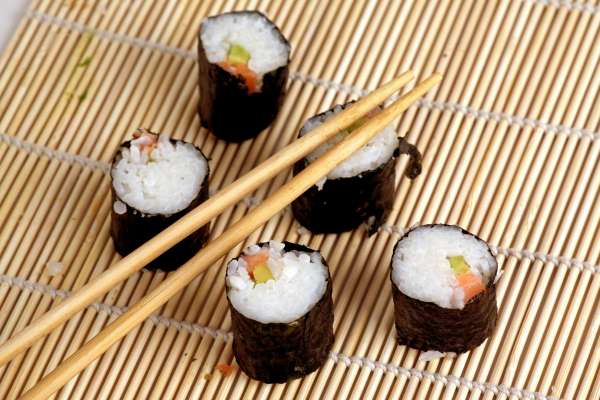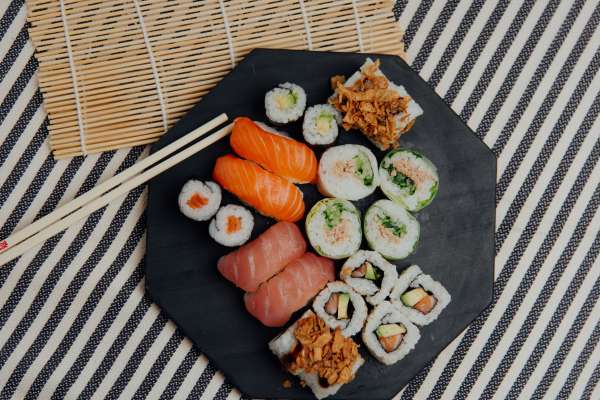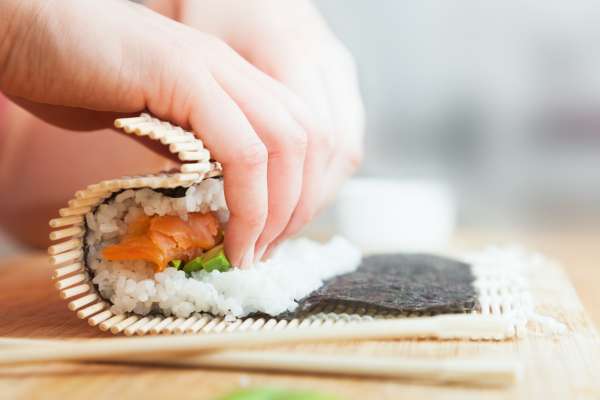Creating sushi at home can be a rewarding and exciting culinary experience. While it’s traditional to use a bamboo sushi mat (makisu) to achieve the tight roll required for sushi, it’s entirely possible to roll sushi without one. The key is to have the right ingredients On hand And Be patient with the process.
This guide will walk you through the necessary steps to make A sushi roll without a mat, Allowing you to savor this delightful Japanese delicacy at your convenience. You’ll need sushi-grade fish (if making non-vegetarian sushi), sushi rice, nori (seaweed sheets), and your choice of fillings.
What Is Sushi?
Sushi is A traditional Japanese dish celebrated worldwide for its unique blend of flavors And textures. At its core, sushi is vinegared rice (known as sushi rice) combined with various ingredients such as raw or cooked seafood, vegetables, and occasionally tropical fruits. Sushi comes in several forms, the most common being maki (rolled sushi, which includes fillings wrapped in rice and a seaweed sheet called nori), nigiri (hand-pressed rice topped with a piece of seafood), and sashimi (sliced raw fish served without rice). The craft of sushi making is highly revered in Japan And has been elevated to an art form, With chefs often undergoing years of training to master the skills necessary for sushi preparation.
Required Ingredients
For basic sushi rolls, You’ll need the following ingredients:
- Sushi Rice: This is A special kind of short-grain rice known for its sticky texture when cooked. It’s key to sushi as it holds the roll together.
- Rice Vinegar: Used to season the sushi rice, giving it a mildly sweet and tangy flavor.
- Nori Sheets: These are thin sheets of dried seaweed used to wrap the sushi roll. Nori is edible and has a unique, briny flavor.
- Fillings: These can vary widely based on preference and dietary needs. Common fillings include sushi-grade fish like tuna or salmon, cooked shrimp, crab or eel, And a variety Of vegetables like cucumber, avocado, and carrot.
- Soy Sauce: For dipping your sushi rolls.
- Wasabi and Pickled Ginger: Traditional accompaniments for sushi. Wasabi is a spicy Japanese horseradish, and pickled ginger (gari) is used to cleanse the palate between different types of sushi.
- Sesame Seeds (optional): Often used as a garnish, adding a nice crunch and flavor to the sushi roll.
The Role Of The Sushi Mat

A sushi mat, known as a makisu in Japanese, is a flexible bamboo mat that plays a vital role in the process of making sushi, especially when creating maki (rolled sushi). The mat’s main function is to provide structure and pressure, allowing for a consistent and tight roll that keeps the sushi together when sliced and served. The makisu’s evenly spaced bamboo sticks and the flexibility it offers make it an ideal tool for rolling sushi. However, despite its traditional use, one can still create sushi rolls without a mat by employing careful techniques and patience, resulting in delicious homemade sushi that holds together well.
Why Make Sushi Without A Mat?
Making sushi without a mat might seem unconventional, But it can be An excellent option for beginners who are eager to try their hand at sushi-making but don’t have all the traditional tools. Additionally, it’s a great solution for those who find themselves with A sudden sushi craving but don’t have A sushi mat at home. Learning to make sushi without a mat also hones your dexterity and understanding of the balance between ingredients. This approach adds versatility to your culinary skills and demonstrates that delightful sushi can be created with minimal equipment, making it a more accessible and spontaneous option for home cooking.
Traditional Sushi Making Process
1. Convenience And Flexibility

The traditional process of making sushi involves several steps. First, the sushi rice is prepared by rinsing the rice thoroughly And cooking it, After which it’s seasoned with A mixture Of rice vinegar, sugar, and salt. The seasoned rice is then spread onto a nori sheet placed on a bamboo sushi mat. Fillings, such as fish or vegetables, are arranged in a line on the rice. Using the mat as a guide, the sushi is then rolled tightly, forming a cylindrical shape. The roll is Then sliced into bite-sized pieces with A sharp knife. This process requires skill and practice to achieve the right balance of ingredients and the perfect roll.
2. Convenience And Flexibility

Making sushi without a mat can offer an element of convenience and flexibility. It means you can create sushi wherever you have access to the ingredients, Even if you don’t have your sushi-making tools on hand. It also allows for flexibility in the shape and size of your sushi. Without the confines of a mat, you’re free to experiment with less traditional, more free-form rolls.
3. Unavailability Of A Sushi Mat

There might be situations where A sushi mat isn’t readily available you may be traveling, living in A place where it’s hard to find one, Or you simply haven’t got around to purchasing one yet. In such cases, knowing how to roll sushi without a mat can come in handy. You can still enjoy the process of making and eating homemade sushi, using everyday kitchen tools and items as substitutes for a sushi mat.
How To Roll Sushi Without A Mat
1. Gather Your Ingredients

Start by assembling all your sushi ingredients. You’ll need sushi rice, nori sheets, your chosen fillings (which could include sushi-grade fish, cooked vegetables, raw vegetables, etc.), and any additional seasonings or garnishes you like, such as sesame seeds or soy sauce. If you’re using sushi-grade fish or other raw ingredients, be sure to handle them safely to avoid cross-contamination.
2. Prepare Your Station
Lay a clean kitchen towel on A flat surface And place A sheet of plastic wrap on top of it. The kitchen towel will give you a sturdy base and the plastic wrap will prevent the sushi rice from sticking to the towel. Place a nori sheet on the plastic wrap, and wet your hands to prevent the rice from sticking to them. Take a handful of sushi rice and evenly spread it across the nori sheet, leaving about an inch at the top for sealing the roll.
3. Roll Your Sushi

Lay your chosen fillings in a horizontal line at the bottom of the nori sheet. Using the towel and plastic wrap, carefully roll the sushi, applying even pressure to keep the roll tight. As you roll, pull back on the towel and plastic wrap so they don’t get rolled into the sushi. Continue until the roll is complete, using a bit of water to seal the edge of the nori sheet.
4. Cut And Serve Your Sushi
With A sharp knife, Cut the sushi roll into bite-sized pieces. It’s helpful to clean the knife with a wet cloth between each cut to prevent sticking. Serve the sushi with soy sauce, wasabi, and pickled ginger. Enjoy the fruit of your labor – a delicious sushi roll made without a mat! Remember, The key is practice, So don’t be discouraged if your first few rolls aren’t perfect.
Tips For Perfect Sushi Roll Without Mat
- Rice Preparation: The texture and flavor of the rice are crucial for sushi. Rinse the rice until the water runs clear before cooking to remove excess starch. Once cooked, season it with a mixture of rice vinegar, sugar, and salt for the characteristic sushi rice flavor. Let it cool to room temperature before using it to roll sushi.
- Manage the Stickiness: Sushi rice is very sticky. Keep a bowl of water nearby when preparing sushi to dip your fingers in and prevent the rice from sticking to your hands. When spreading the rice on the nori sheet, wet your fingers and gently spread the rice to get a thin and even layer.
- Be Mindful of the Fillings: Don’t overfill your sushi roll. It can make the roll difficult to seal and lead to the fillings spilling out when you cut the roll. Remember, less is more.
- Rolling Technique: Apply even pressure when rolling your sushi to ensure it holds together well. As you roll, try to keep the roll tight. This is key to sushi that doesn’t fall apart when you cut or eat it.
- Cutting the Sushi: Use a very sharp knife to cut your sushi roll into pieces. A dull knife can squash the roll and cause the fillings to spill out. Wet the blade with water or vinegar before each cut to prevent the rice from sticking.
- Patience and Practice: Perfect sushi rolling, especially without a mat, requires practice. Be patient with the process and don’t be discouraged if your early attempts don’t look perfect. The more You practice, The better you’ll get.
- Experiment and Enjoy: Sushi is highly customizable. Feel free to experiment With different fillings And flavors. The most important thing is to enjoy both the process Of making sushi And the delicious result.
Potential Challenges And Solutions
Making sushi without a mat can come with a few challenges. However, with a bit of practice and the right techniques, you can overcome these obstacles:
Challenge: 01
The Sushi Roll Isn’t Tight Enough: One of the most common problems when rolling sushi without a mat is getting a firm, tight roll. Without the structure of a sushi mat, your roll might be too loose, causing it to fall apart when cut or eaten.
Solution: You can use a kitchen towel and plastic wrap to aid in the rolling process, providing some of the structure and tightness that a sushi mat would offer. Apply consistent, even pressure as you roll, and be sure to tuck the edge of the nori sheet in as you go to get a firm roll.
Challenge: 02
The Rice Is Sticking to Hands or Knife: Sushi rice is sticky, and it can be tricky to work with. It might stick to your hands as you’re trying to spread it on the nori sheet, or to your knife when you’re trying to cut the roll.
Solution: Keep a bowl of water or a damp cloth nearby while you’re working. Wet your hands before handling the rice to keep it from sticking to them, and clean your knife between each cut to get clean, neat pieces of sushi.
Challenge: 03
Overfilling the Roll: When you’re choosing fillings for your sushi roll, you might be tempted to add a lot. However, overfilling your roll can make it hard to close and cut, and the fillings might spill out when you try to eat it.
Solution: Less is more when it comes to sushi fillings. Choose A few key ingredients And use them sparingly. Remember, sushi is about balance, And you want to Be able to taste the rice as well as the fillings.
Challenge: 04
The Roll Isn’t Sealing Properly: If your roll isn’t sealing at the end, it can come undone when you try to cut or eat it.
Solution: Leave about an inch of the nori sheet at the top without any rice on it. When you’ve finished rolling, you can wet this strip of nori and it will act like glue to seal your roll.
The Final Thoughts
Rolling sushi without a mat is a feasible and fun culinary adventure, especially when traditional tools are not readily available. The process involves gathering the right ingredients, preparing your station with a kitchen towel and plastic wrap, carefully assembling your sushi with a balance of flavors, and rolling with even pressure to achieve a tight roll. Remember, cutting your sushi with a clean, sharp knife is key to neat, bite-sized pieces. While it might pose a few challenges initially, like managing the stickiness of rice and ensuring a tightly rolled sushi. These can be overcome with practice and patience. Whether you’re a sushi enthusiast, a home cook looking for new challenges, or someone who simply can’t find a sushi mat, mastering sushi rolling without a mat can open a new dimension in your culinary journey.
